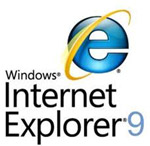
Internet Explorer 9: A Step Forward

If you keep up with tech blogs at all, you probably have heard about Microsoft’s release of the Internet Explorer 9 Beta. Chances are you probably heard about it through some kind of article talking about its support for modern web standards like HTML5 and CSS3. The day of the Beta release, our Twitter feed was filled with posts about how awesome HTML5 is, and how IE9 supports it. I think this article on Slate put it best:
“Wednesday’s demo was so heavy on the new browser’s graphical capabilities that you’d think Microsoft invented HTML5, instead of just now getting around to making a browser that supports it.”
HTML5 is a fairly new standard that has been in a work-in-progress for a couple years. Most modern browsers such as Firefox, Chrome, and Safari have been implementing HTML5 support since its beginning. Internet Explorer on the other hand, has completely lacked any HTML5 support – until the upcoming Internet Explorer 9. Due to lack of support across the board, HTML5 is something that hasn’t quite caught on with most web developers, but is definitely gaining steam – especially with the release of Apple’s iPad. Because the iPad lacks Flash support, many sites with interactive content would not display correctly. So since HTML5 supports a lot of the functionality that developers were using Flash to create, and Safari has extensive HTML5 support, Apple used this to their advantage and pushed the web to begin using this new medium. Unfortunately for many of us web designers/developers, using new features that Internet Explorer doesn’t support effectively ignores about 50% of your website visitors, thus creating a larger demand for Internet Explorer to step up and join the rest of the standards-compliant web.
(On a related note, last year I wrote a post titled Why Web Browser Updates are Necessary that touches a lot more on the subject of cross-browser compatibility and standards compliance.)
That’s where IE9 comes in. This new version of the popular browser touts extensive web standards support, including HTML5 and CSS3, which both bring an arsenal of features for making designing and building web sites easier while focusing on functionality. As for the actual program, this is probably the biggest redesign to the Internet Explorer interface I’ve seen since the introduction of tabbed browsing. Microsoft really seems to have stepped back and rethought their product’s functionality in this release, much like with Windows 7. Many current features have been reworked, while other new features have been added to integrate the experience with Windows 7, such as the ability to pin sites to your taskbar. Microsoft has a complete list of new features here. They also have a comparison chart of the different features of all versions of Internet Explorer.
With all this new standards compliant goodness Microsoft is gracing us with, there are unfortunately some drawbacks. IE9 – at least in the Beta, I can’t say for sure for the full release – requires Windows Vista or higher to run, so you XP users are stuck with IE8 unless you want to switch to a different browser or upgrade your OS (on a side note – I personally upgraded from Windows XP to Windows 7 last year and the speed increase alone is definitely worth the upgrade!). This means that in order to get IE users to a standards-compliant browser, many must also upgrade their operating systems to do so. I personally don’t see this happening any time soon, since getting people to upgrade from IE6 (an 8 year old browser) has only just recently shown improvement. Even though IE9 is a significant step forward for Microsoft in terms of joining the rest of the web, without the discontinued support for Windows XP or older versions of Internet Explorer, people will continue to use their old software, thus continuing to hold back the progress of web technology.
To summarize, there are many contenders in the war for your web browsing usage, and Microsoft is finally putting up enough of a fight to join in on the competition. They’ve left quite a few of their users behind in the process, which might drive them to Firefox or Chrome – but hey, at least they’ll be using a modern browser! Not including XP in this release, Microsoft’s message is clear – maybe it’s time for XP users to upgrade?
By the way, for those who decide to make the move to Windows 7, LearnKey offers a Learning Windows 7 course for newcomers to the OS, and we released several additional scenes from that course under the Tutorials category on our blog this past summer.
3 thoughts on “Internet Explorer 9: A Step Forward”
Comments are closed.
It is about time that IE came up with a decent browser, although I’ll believe it when I see it. The sad thing is, even if IE 9 does blow all the previous versions away, so many IE users don’t even know that they should upgrade. I still know people out there using IE 6, which is essentially equivalent to the Devil’s spawn.
I love how they will actually get credit for making a browser that renders to current standards (badly). They should be leading the way in this field, not getting patted on the back for trying to copy Google Chrome.